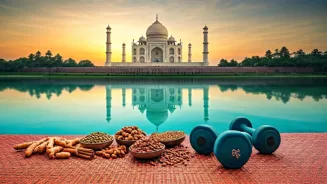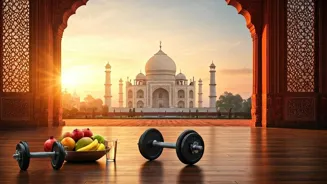Explore the fascinating evolution of exercise trends from ancient practices to modern fads in "The History of Fitness."
Namaste readers! Ever wondered how our quest for a healthy life has changed over the
years? Fitness, as a concept, isn't new. But the way we approach it – the 'how' – has seen quite a transformation.

Let’s take a trip down memory lane and explore the fascinating evolution of exercise trends in India and the world, from the ancient practices to the modern-day fads. You'll be surprised to see how much things have changed, and perhaps even inspired to try something new!
Fitness in ancient times focused on functionality, not aesthetics
In the early days, fitness wasn’t about six-pack abs or fitting into skinny jeans. It was purely functional. In ancient India, practices like Yoga were developed not just for physical strength but also for mental and spiritual well-being.
Yoga focused on flexibility, balance, and inner peace, all achieved through precise postures (asanas) and controlled breathing (pranayama). Similarly, martial arts like Kalaripayattu were designed to build strength, agility, and self-defense skills, essential for survival and protection.
These activities were integrated into daily life, blurring the lines between exercise and routine. In other parts of the world, civilizations thrived on physical prowess gained from farming, hunting, and warfare. Fitness was a necessity, not a choice.
There were communities that thrived on making themselves physically fit as it was required for their day job (farming) and it helped them to maintain a healthy mind and body.
The 20th century saw a rise in fitness trends promoting exercise for health and vitality
The 20th century brought about significant shifts in fitness trends. With the rise of industrialization and desk jobs, people started dedicating specific time to exercise. The early 1900s saw the emergence of physical culture movements, emphasizing strength and bodybuilding.
Strongmen like Eugen Sandow, a performer and bodybuilder, became international celebrities, promoting the idea of sculpted physiques as a symbol of health and vitality. Gymnastics gained popularity, with its focus on strength, flexibility, and coordination.
As the century progressed, exercise became increasingly accessible with the opening of local gyms. These small gyms played a very important role in encouraging young and older people to start doing exercise and become fit.
These activities were accessible, providing methods to enhance their personal fitness and overall well-being. Yoga continued to be a very popular habit that many people used to follow.
The aerobics craze of the mid-20th century revolutionized fitness
The mid-20th century witnessed the aerobics craze! Jane Fonda's workout videos revolutionized the fitness industry, bringing exercise into homes and making it fun and accessible. Aerobics emphasized cardiovascular fitness through rhythmic movements, often performed to music.
This era also saw the rise of jogging and running, propelled by the scientific understanding of the benefits of endurance training. People started lacing up their shoes and hitting the streets, motivated by health and weight loss goals.
Even here in India, simple physical exercises were preached by many gurus. This was the time when people started paying attention to fitness and health. A lot of people started focusing on being physically fit and a healthy mind was also given more importance.
The 1980s and 1990s saw fitness trends explode globally
The 1980s and 1990s introduced a whole new wave of fitness trends. Gym culture exploded, with the introduction of new equipment and training methods. Strength training became increasingly popular, with bodybuilders like Arnold Schwarzenegger inspiring a generation to lift weights and build muscle.
The rise of fitness magazines and television shows further fueled this trend. Simultaneously, martial arts like Taekwondo and Karate gained popularity for self-defense and discipline. In India, yoga continued to evolve, with various styles emerging and gaining international recognition.
Many were seen in rural areas also gaining interest in physical exercise. Local schools and collages also kept emphasizing that fitness and health will make them a good human being.
Modern fitness: personalized, tech-driven, data-rich workouts for all
The 21st century is marked by personalized fitness and technology advancements. We have a plethora of options to choose from, from CrossFit and Zumba to Pilates and spinning.
Wearable fitness trackers and smartphone apps monitor our activity levels, providing data-driven insights to optimize our workouts. Online fitness classes and virtual personal trainers bring exercise right into our living rooms.
The focus has shifted from generic fitness routines to personalized plans tailored to individual needs and goals. We have a lot of data available and we know what to do based on the data. This helps us achieve our fitness goals in a easier way.
People are now also aware of benefits of exercise and fitness.
Fitness trends: holistic well-being, mindful movement, nutrition importance, personalized future
Today, the fitness landscape is more diverse than ever. There's a growing emphasis on holistic well-being, encompassing not just physical fitness but also mental and emotional health. Mindful movement practices like yoga and Tai Chi are gaining popularity.

People are recognizing the importance of nutrition and recovery in achieving optimal fitness. We're also seeing a resurgence of traditional Indian fitness practices like yoga and Ayurveda, combined with modern techniques to create a balanced approach.
The future of fitness promises to be even more personalized and integrated into our daily lives, driven by technology and a deeper understanding of the mind-body connection. So, find an activity you enjoy, be consistent, and remember that fitness is a journey, not a destination!
AI Generated Content. Glance/InMobi shall have no liability for the content










